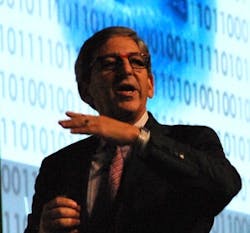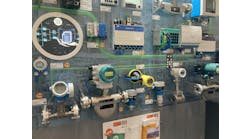That was the main question considered and answered during a keynote address and panel discussion today at ABB Automation & Power World in Houston. The keynote, "Business Transformation with the Internet of Things," was presented by Norm Judah, CTO of Microsoft Services, who reported that ABB and Microsoft have been partnering and innovating together for many years. The panel discussion also included Frank Berry, process controls group manager for Air Products, Greg Scheu, president of ABB's Americas region, and was moderated by Keith Larson, VP of content for Putman Media, publisher of Control.
"We've enjoyed jumping into IoT with both feet, and it's been a big game changer for us" said Berry. "We think it really began with our rapid advances in remote connections, monitoring and configuration." Berry reported that Air Products began by building its Remote Operations Center a few years ago, and then connecting it 24/7 to hundreds of manufacturing facilities.
"We've gone from polling our plants for data to having them push it to us," added Berry. "This has allowed us to mine cyclic and acyclic data, create better KPIs [key performance indicators] and dashboards, and do better predictive maintenance. The short-term challenge is inconsistency. Because we have many plants with different suppliers and equipment, it's still difficult to provide consistent solutions."
'Our best technical knowledge'
"The step change is that now we have analytics and machine learning, and can more easily do predictive maintenance and optimization." Microsoft's Norm Judah on the business case for IoT implementations across industry.
Air Products operates about 750 plants in 30 countries. "It's hard to spread expert knowledge across all these sites, so our remote center allows us to gather data, and do condition monitoring. And then, we can supply our best technical knowledge to all of them, instead going site by site. It even improves quality of life for our operators because we can run some facilities unmanned, and just visit them occasionally."Likewise, Scheu added that ABB has $400 billion worth of equipment deployed in 80 countries, including transformers, motors, robots and other devices, which may run for 20 to 40 years or more. "Digital models and IoT will let us see how this equipment is supposed to run, but then also let us compare how it's running in the real world, so we no longer have to run it to failure" said Scheu. "This will be a big part of improving uptime and reliability."
In his keynote, Judah reported, "The broad framework that IoT grew out of included finance, business data and then ERP [enterprise resources planning] systems, but the level of engagement really took off when sales, field services and backend personnel began to use them. More recently, systems of insight that look at real-time, transactional information have been growing in many industries, and allowing them to look at massive, deep levels of data for broad operations. IoT fits in to enable data collection, including reference data from inside and outside of organizations. However, the step change is that now we have analytics and machine learning, and can more easily do predictive maintenance and optimization."
Judah added that the present IoT revolution is being driven by standardization of networking components and communication protocols and by the commoditization of microprocessors and board-level computing power, which have reduced the cost of these components by orders of magnitude. "This means users can take measurements and communicate much less expensively, and it's fueling a massive increase in these devices, which means more connectivity and a lot more data. But the question is how to analyze it and get useful feedback?"
Revenue from Big Data
Judah reported that Big Data is where IoT will generate revenue by enabling predictive maintenance, but he added it will also spark designs for entirely new systems and products. This is happening because IoT alters the time constant from when users interact with their own customers from weeks and days down to hours and even minutes. IoT allows correlations and patterns to be found in the data generated; and this helps new business models to be developed. Even though IoT devices are exploding in popularity and usage levels, Judah predicted they'll even busier and more prevalent in the next five years, and will be measuring and controlling even more parameters.
"For instance, Thyssen Krupp builds heavily instrumented elevators, which are now bringing data into a centrally located facility," said Judah. "This is allowing the company to offer its elevators as a service, but none of this would be possible without all of its new measurements. IoT will change many industries in the same way by building these consumptive and subscription-based models."
Berry added that, despite generating huge amounts of data, Air Products prioritizes its efforts by requiring a specific business case for the data it wants. "Instead of the shotgun approach of collecting all the data we can, we take more of a rifle-shot approach," explained Berry. "We ask who is going to look at this data, and what are they going to do with it? If they're not sure, then we say to come back later."
"Meanwhile, IoT devices themselves are still fundamentally insecure," added Judah. "And, because these devices aren't secure, users need to ask: what is the identification for this device, and what is it being allowed to do?" explained Judah. "IoT components are like people, and so they need security to do what they're asked to do."








